
Living up to the title of Green City
During the 2021 budget announcement in February, the government announced their commitment to meet the global challenge of climate change by building a sustainable Singapore. To do so, they announced the Green Plan 2030, a long-term plan that builds on ongoing efforts to achieve sustainability. The plan introduces more greenery to Singapore to transform our city-state into a City in Nature, strengthening both sustainability education and efforts among our young.
Recently, the Singapore Government announced their commitment to becoming increasingly energy efficient via the adoption of electric vehicles (EVs). In this article, we’ll be highlighting the schemes involved in their push for electric vehicles and dissect how these initiatives impact the property landscape.
Previously on the EV Front
Singapore’s journey to widespread EV adoption goes back to as early as 1994. However, it failed to gain traction due to the generally prohibitive prices and lack of commercial availability. In 2009, the Energy Market Authority (EMA) and Land Transport Authority (LTA) set up an EV task force to continue monitoring the situation.
In 2014, the task force announced plans to trial an EV car-sharing programme involving the introduction of up to 1,000 EVs with supporting charging infrastructure. In 2017, we took larger strides when taxi operator HDT Singapore Taxi deployed their first fleet of electric taxis, and a nationwide car-sharing programme kicked off with electric car-sharing firm BlueSG (some of our peeps in office do use it rather religiously).
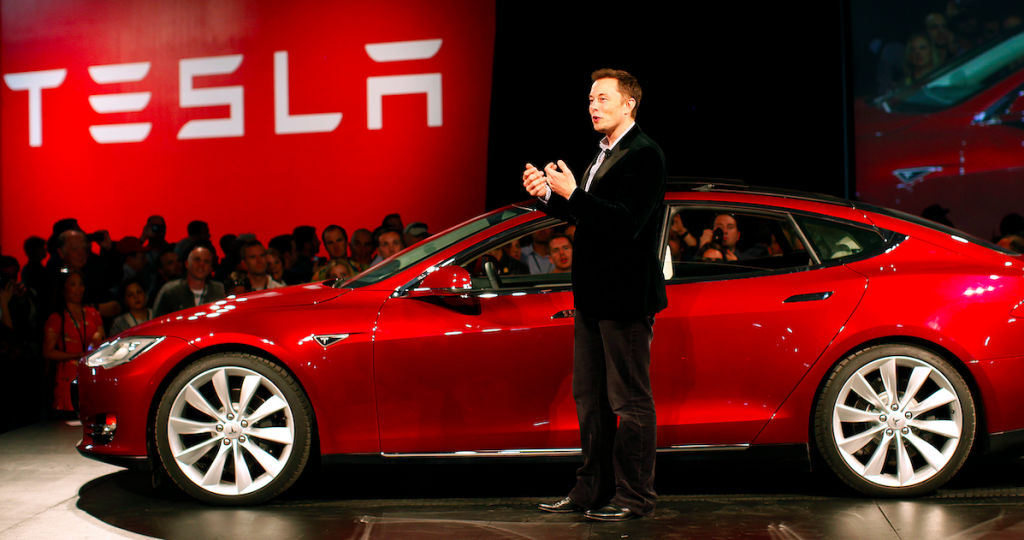
Elon Musk and Tesla Courtesy VulcanPost
However, in 2019, Elon Musk, the founder of tech and EV giant Tesla tweeted accusing the Singaporean government of being unsupportive of EVs. In response, then-Environment and Water Resources Minister Masagos Zulkifli said that Singapore was interested in a climate solution, not a lifestyle.
Nonetheless, in the last two years, Singapore has seen a resurgence of interest and efforts in the adoption of Electric Vehicles. According to a TODAY article, this could be attributed to increased affordability of batteries required in the manufacturing of EVs. With the lower battery prices, EV costs are slowly levelling with vehicles with Internal Combustion Engines (ICEs). In the same article, Professor Mhaisalkar from NTU anticipates that a tipping point would be achieved when battery prices fall to a range of US$5,000 to US$10,000 per vehicle. This has also been forecasted to occur by 2025.
While the evolution of EV technology still has a long way to go, the government has notably stepped up on their efforts to transition Singapore to a car-lite future.
Recent Government Initiatives
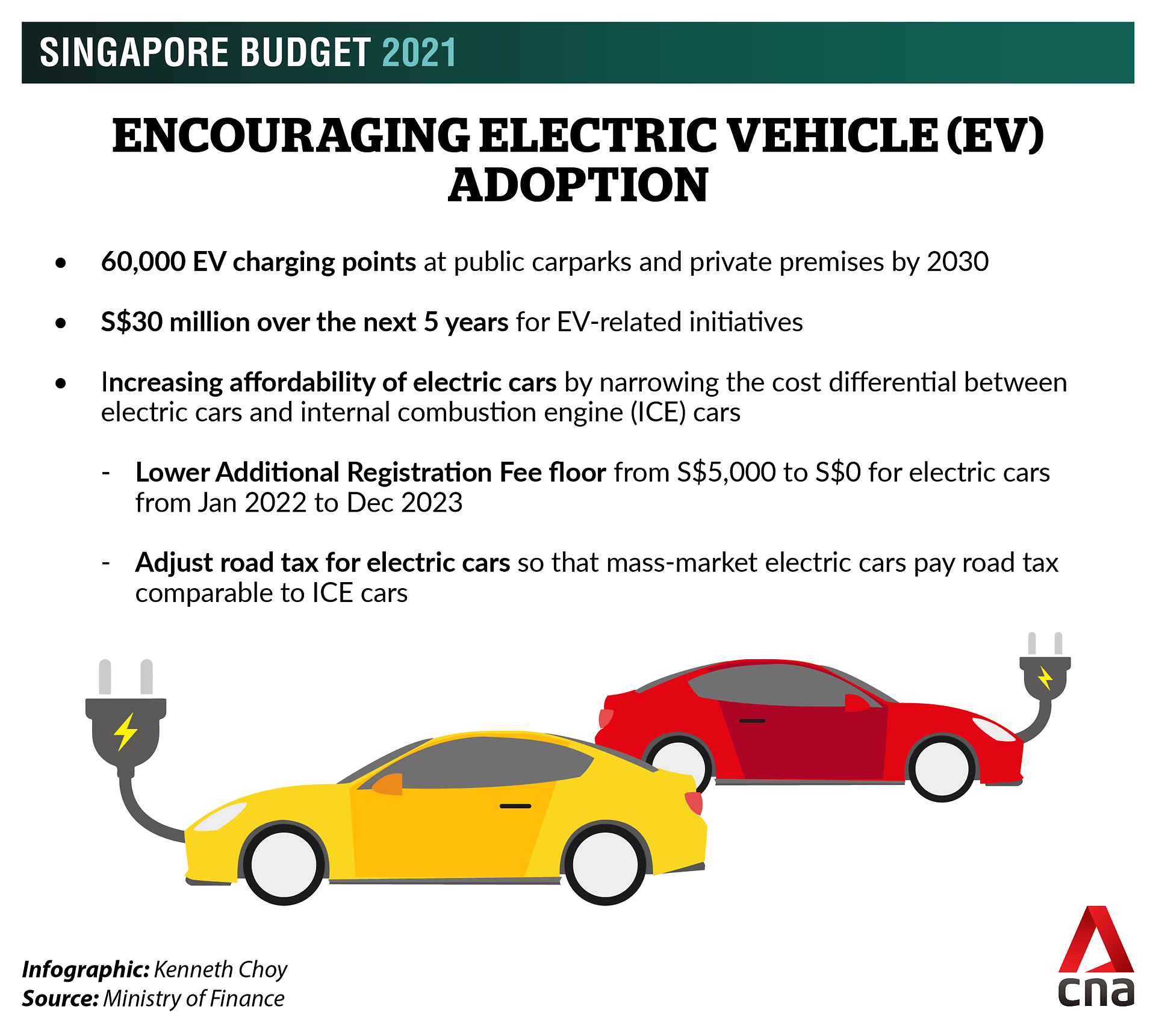
EV Adoption Budget 2021 Courtesy Ministry of Finance and CNA
The push for adopting electric vehicles is not a new one. In Budget 2020, the government announced their initial plan to have all vehicles run on cleaner energy by 2040. Before that, Deloitte’s 2018 Global Automotive Consumer Survey, highlighted two key issues hindering EV adoption that governments could tackle. Firstly, the cost premium of adopting EVs and secondly the lack of dense national charging infrastructure.
Price Concerns
Yahoo Finance compiled a table illustrating the popular electric car models in Singapore and their respective prices.
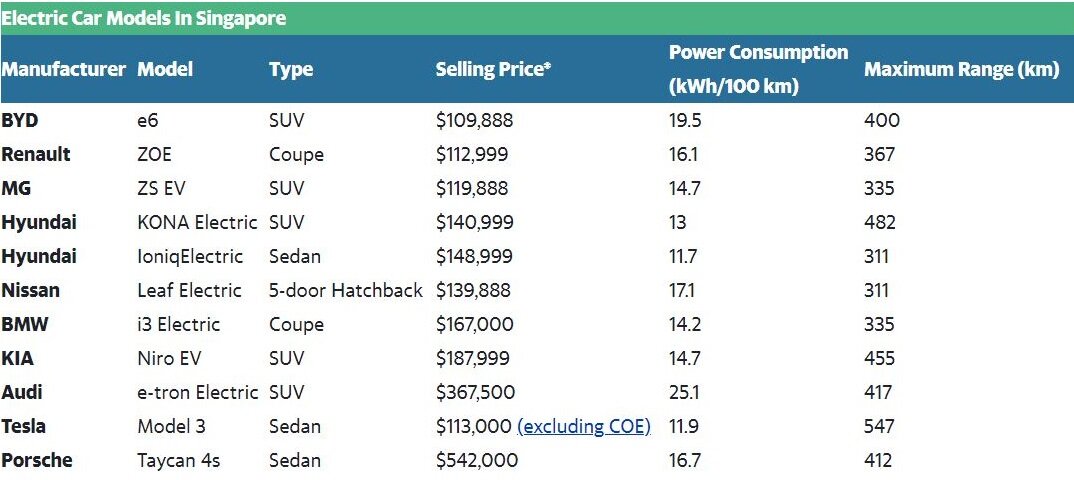
Electric Car Models and Prices Courtesy Yahoo Finance
The table illustrates just how expensive electric cars are currently. To tackle this prohibitive price tag, the state first introduced multiple schemes. Here’s a summary table for clarity:

Firstly, their Enhanced Vehicular Emissions Scheme (VES) was introduced in 2020 and builds on the previous Vehicular Emissions Scheme. The VES applies to EVs registered from 1 January 2021 to 31 December 2022. According to the scheme, rebates or surcharges are administered based on a vehicle’s carbon dioxide (CO2) emission, plus emissions of four pollutants – hydrocarbons (HC), carbon monoxide (CO), nitrogen oxides (NOx) and particulate matter (PM). Following the scheme, those who register an EV within the next two years would be able to enjoy rebates of S$25,000.
Secondly, they introduced the EV Early Adoption Incentive (EEAI) in 2020. It provides rebates of up to 45% on the Additional Registration Fee, capped at S$20,000 and effective from January 2021 to January 2023. The incentive is awarded to those who purchase fully electric cars and taxis and LTA claimed that this initiative would lower the upfront cost of an electric vehicle by an average of 11%.
In 2021, the government built on this existing incentive when they announced further reductions in the Additional Registration Fee to zero, effective from January 2022 to December 2023. Additional Registration fees make up a large proportion of the cost of owning a car in Singapore, ranging from 100% to 180% of the vehicle’s Open Market Value (OMV). Thus, with the additional rebate, we can expect a much lower upfront cost for EVs and a levelling between the purchase price of vehicles with Internal Combustion Engines (ICEs).
Thirdly, EV road tax rates are expected to fall. During Budget 2021, Mr Heng announced that he will “revise the road tax treatment for electric cars, by adjusting the road tax bands so that a mass-market electric car will have road tax comparable to an ICE equivalent”. The detailed revision schedule can be accessed here. It explicates the changes in road tax for the different power ratings ranges.
Finally, EV users are also expected to spend less in the long run since they no longer have to pay for fuel. While they have to pay to charge their vehicles, they will be spending significantly less than if they owned an ICE vehicle. Moreover because EVs have fewer parts and use clean energy as opposed to fuel that needs to be combusted in ICEs we can also expect less wear and tear resulting in less frequent servicing appointments and further savings.

In 2020, Finance Minister Heng Swee Keat announced how the shift toward EVs would significantly impact Singapore’s tax revenues. He explained that currently, with the mass consumption of petrol, fuel excise duties contribute close to S$1 billion. However, since EVs do not consume petrol, a six-monthly lump sum tax for EVs will be charged to make up the loss. Starting from this year, EV owners will be charged $100, in 2022, they’ll be charged $200 and in 2023, $350. Despite this increase in taxation, EV owners are still expected to see substantial net savings should they register for their vehicle between January 2022 December 2023.
Charging Point Concerns
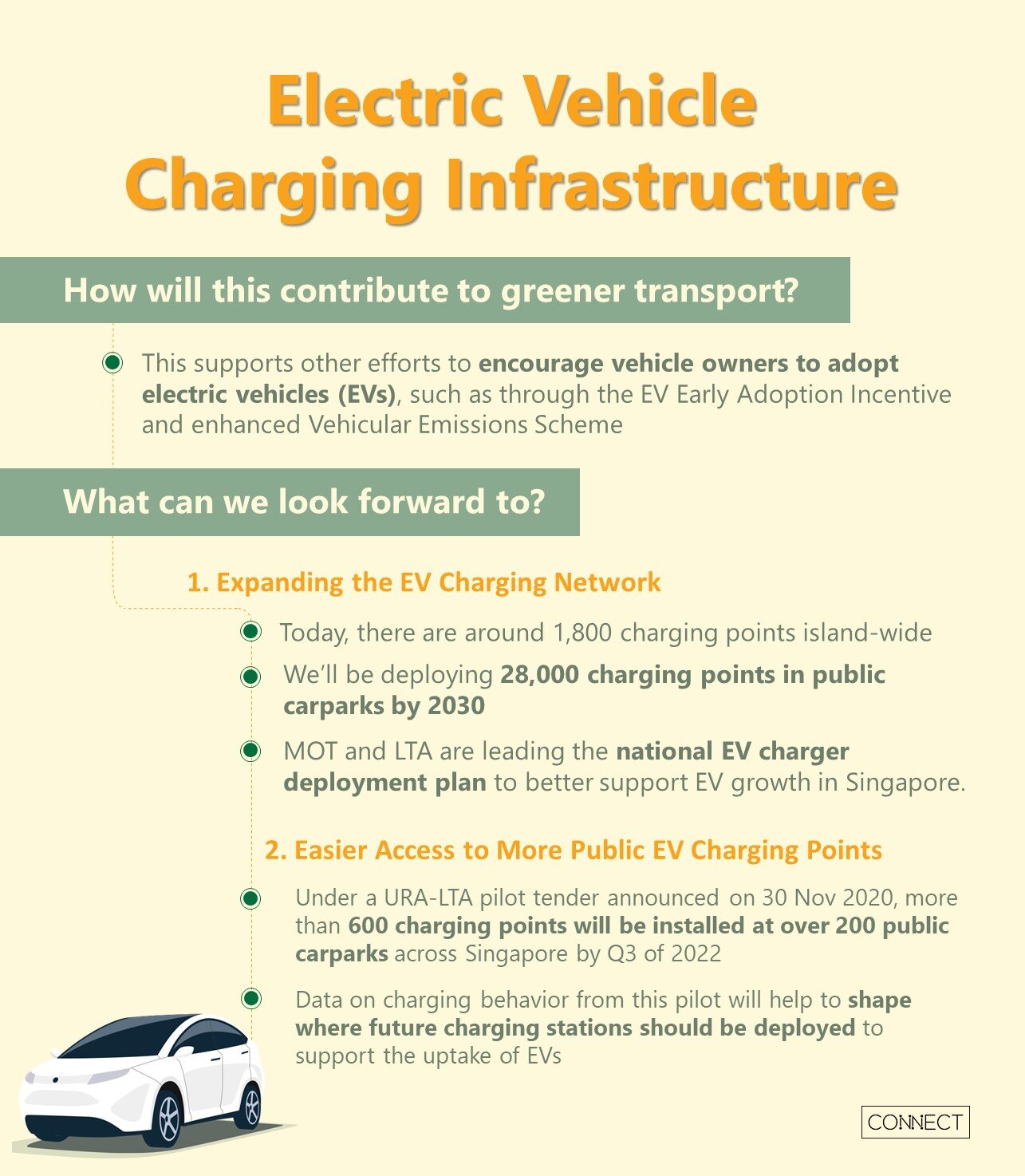
EV Charging Infrastructure Courtesy LTA
While the government can do little to increase the battery lives in EVs, they can provide sufficient charging points around the island to ensure they’re accessible and convenient. This provision of charging points could do much to ease worries regarding EVs’ reliability to get people around the city (range anxiety).
In 2019, Professor Subodh from the Energy Research Institute at NTU highlighted how “The biggest barrier is anyone who doesn’t live in a landed property cannot think about buying an EV”. He also noted how condominiums were unlikely to allow for chargers to be installed. Although in 2019, Singapore had at least 1,300 charging stations provided by SP Group, BlueSG, Shell and ComfortDelGro, most of these stations were not available to the public.
In response to this shortage of public charging stations, during Budget 2020, Mr Heng announced his goal to have 28,000 chargers for public use island-wide by 2030. In Budget 2021, he revised the goal upwards to 60,000 charging points and detailed their plan to achieve this target. He announced that he would “set aside $30 million over the next five years for EV-related initiatives, such as measures to improve charging provision at private premises”.
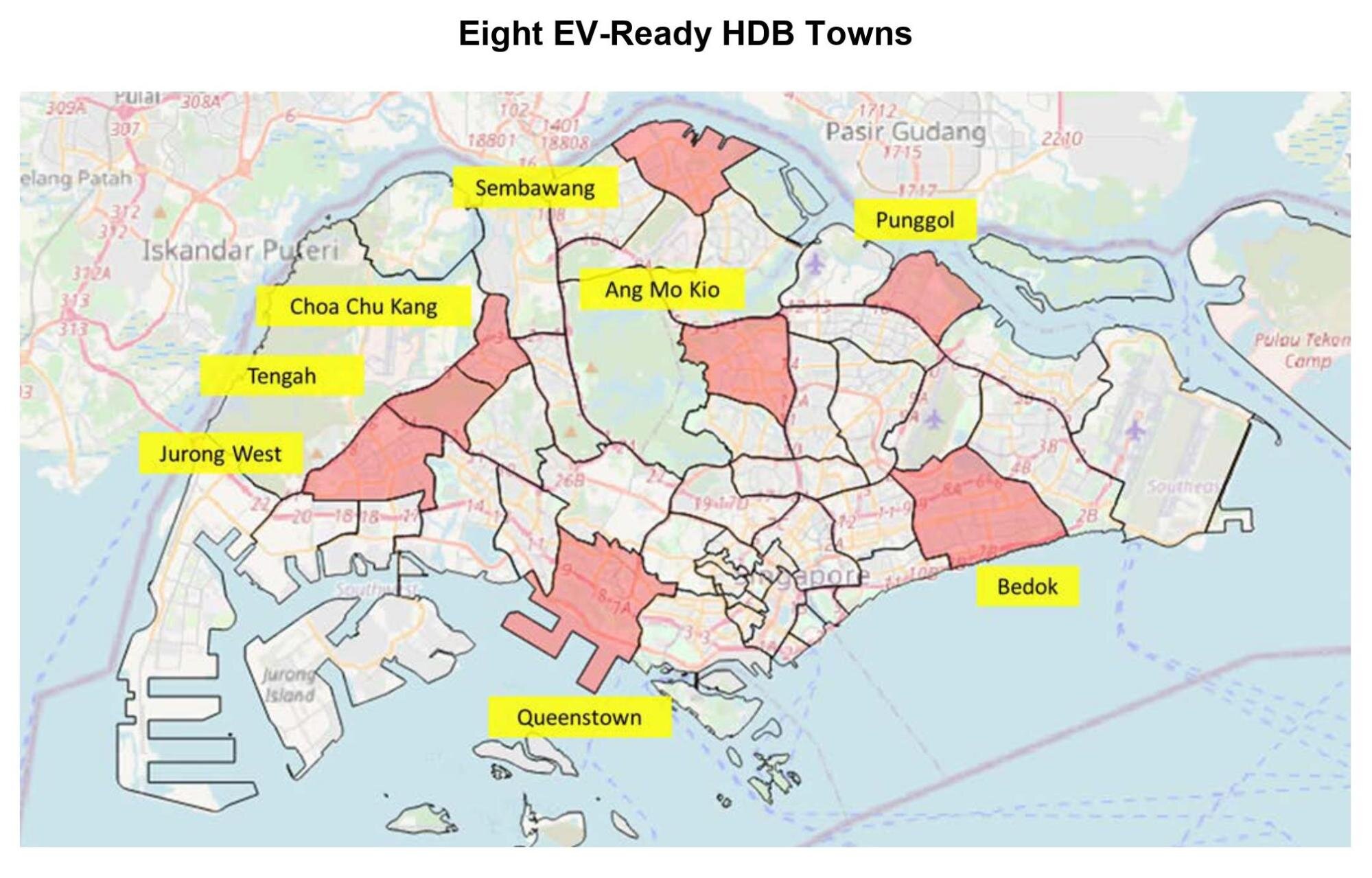
EV Ready Towns Map Courtesy LTA
In turn, over the next 4 years, the state intends to create eight EV-ready towns. The government is targeting to fit HDB car parks in Ang Mo Kio, Bedok, Choa Chu Kang, Jurong West, Punggol, Queenstown, Sembawang and Tengah with EV chargers by 2025. Moreover, they intend to have all HDB carparks EV-ready by 2030.
We can also see from the Budget 2021 statement how their eagerness isn’t limited to HDB towns. They also hope to install more EVs within private properties and local companies have stepped up to achieve this goal. For example, Charge+ is pioneering the movement to cater to condominiums’ undermet EV charging station situation. They’ve come up with a revolutionary subscription model whereby EV drivers will pay a fixed monthly fee that is expected to be half of what ICE vehicle drivers spend monthly on fuel. They’ve also partnered with OCBC bank who would carry out digital payment solutions for the charging services as well as explore financing options for the infrastructure.
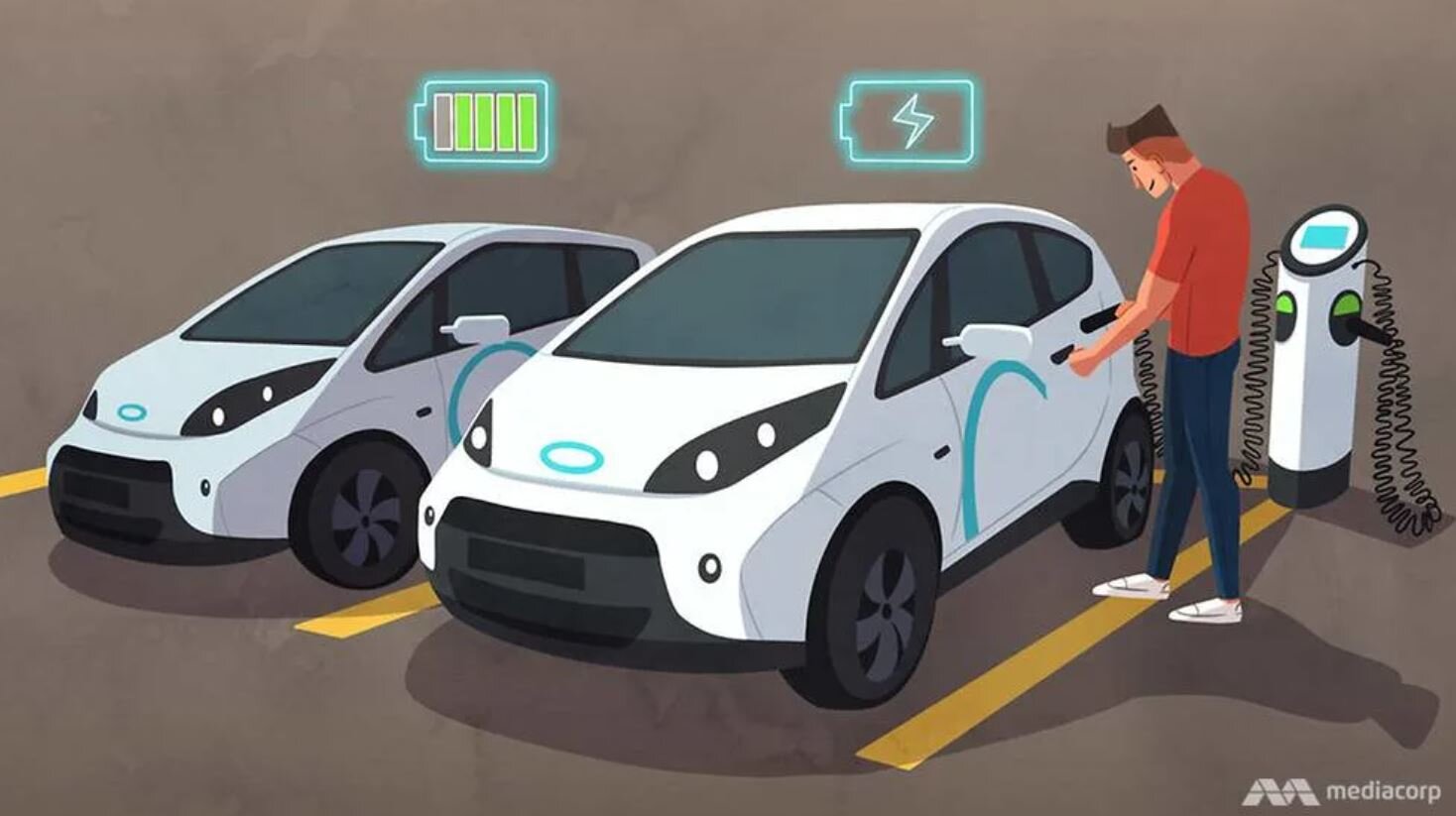
Charging Space for EVs Courtesy MediaCorp
Furthermore, many condominiums were previously reluctant to install EV charging stations due to the budget, time and space they would have to invest. Commercial and Network Director Jenny Lim explicates certain factors developers would have to consider in installing charging points at existing parking lots. She iterates that charging stations would require more space than the typical 4.8m by 2.4m lot to make room for the equipment.
Additionally, trees cannot be cut down to make way for construction and installation works and existing underground cables could inhibit installation works. Finally, in installing EV charging stations outdoors, they’d incur a higher cost of at least 50% more than that in a sheltered HDB carpark since they’d have to do trenching work to hide the cables.
However, to boost the uptake on non-landed residential properties, the government introduced the EV Common Charger Grant (ECCG) that will co-fund the installation of 2,000 chargers in non-landed private residences between July 2021 and December 2023, subject to a cap. LTA will administer the grant, and will release more details in the second quarter of 2021. They will also impose an electrical capacity requirement on private buildings to ensure that the electrical capacity can support EV slow charging for at least 15% of the parking lots.
Moreover, with Charge+ offering to bear the upfront capital outlay, operating expenses and risk, many condominiums have been showing strong interest in. They managed to sign their first partnership with Sky@Eleven condominium located along Thomas Road. They’ll be installing six charging points within the premises for the condominium.
Other prominent landlords like CapitaLand Group and City Developments Limited (CDL) have also entered partnerships with SP Group to provide more charging points in key areas around Singapore such as CBD, Orchard Road and Paya Lebar. CDL has also indicated their interest in expanding their electric vehicle charging infrastructure for new residential properties.
What does the future look like for real estate?
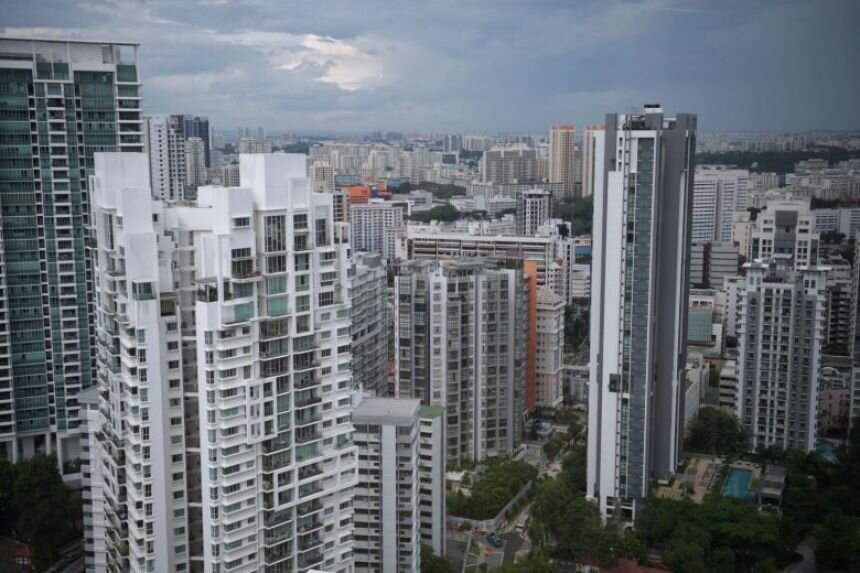
Singapore Property Courtesy The Straits Times
So how does this move for widespread adoption of EVs affect the property landscape?
Firstly, the younger generation is highly eco-centric. This is evident from how many youth have spearheaded eco movements such as Greta Thunberg who challenged world leaders to do their part in the fight for sustainability. Moreover, BlueSG’s success also points toward the shift of public sentiment towards eco-friendly options.

BlueSG Charging Stations
BlueSG was launched in 2017 with the Land Transport Authority (LTA) and the Economic Development Board (EDB). It’s a car sharing platform with a goal of eventually achieving 2000 charging points (400 of which are expected to be available for public use) and a 1,000 strong EV fleet. The service has also been well-received, reaching its one millionth rental in August 2020. Tribecar, another car sharing company have also expressed their commitment to go green. Since 2019, 30% of their fleet were hybrids and 10% were clean diesels. They’ve also placed an order for Tesla Model 3s after the American carmaker’s sales portal went live here with plans to increase the proportion of EVs in their fleet by purchasing Tesla .
Within our own Singapore, a survey conducted by MediaCorp found that 91% of millennials surveyed (those aged between 25 and 34) “agreed” or “strongly agreed” that they were willing to do their part to save the environment. With this group entering the real estate market in the coming years, will these eco facilities become a deal-breaker when they’re looking for their forever homes?
What’s more, with the increased affordability of EVs, more people are expected to take the leap and start purchasing EVs. With that, they’ll probably want to be within close proximity to charging stations. Given that LTA aims to prepare eight towns first, we could possibly see an increase in demand for properties in those areas. Moreover, since most of these eight towns are mature estates, the introduction of these eco-friendly facilities could revitalise these neighbourhoods by introducing the younger generation.
Private properties could leverage on the EV situation to boost their profiles via installing EV friendly facilities like charging ports. But a possible downside to this might be an increase in the cost of condominiums or maintenance costs if the developers have to bear these costs. This might be frustrating for ICE vehicle owners if they have to pay a premium on their homes without being able to enjoy the facilities.
Beyond residential properties, widespread EV adoption could also affect office spaces in the future whereby Grade A office towers will have to start an early adoption to rope in the growing niche. For example, Midtown Modern and Midtown Bay, which are in the middle of the Grade A Office Tower of Guoco Midtown, may have the perfect opportunity to leverage on the Government’s efforts to encourage EV adoption. This will not only help the residences take-up rate, but also garner interest in the network hub and positioning the development perfectly.
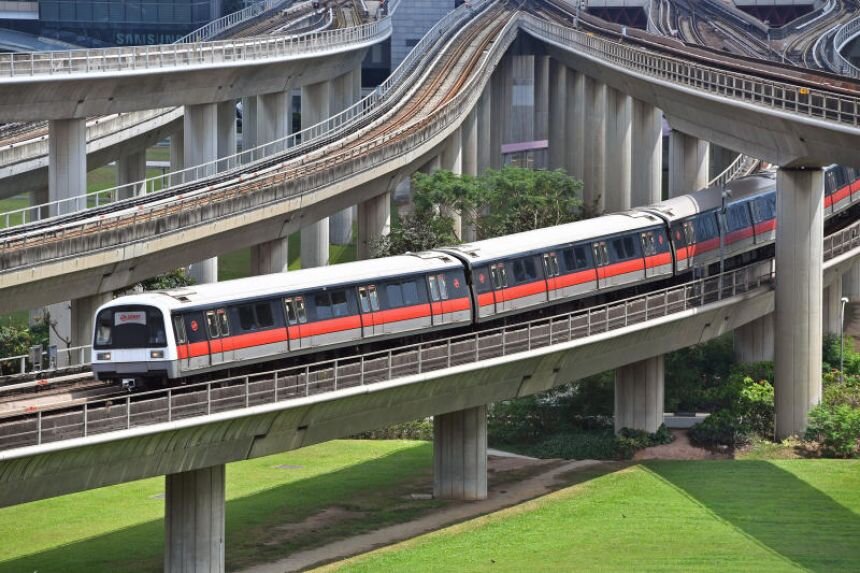
MRT in Singapore Courtesy The Straits Times
While EVs are a great eco-friendly option for those who prefer driving, ultimately the most sustainable option will still be public transport. As seen in this CNA article, the author details how although she has a driver’s licence, she would still not opt for an EV. She explains that the ever-improving public transport system works well enough for her and how she’s able to save money while simultaneously protecting the environment.
Food For Thought
How do you guys think the property landscape will change with the push for environmentally friendly features in developments? Are eco-friendly features deal-breakers for you in your search for your future homes? If so, feel free to reach out to our dedicated team here. With their expertise they could point you to various green developments that meet your needs. For more informational articles and property reviews, check out our blog here. See you in the next one!








